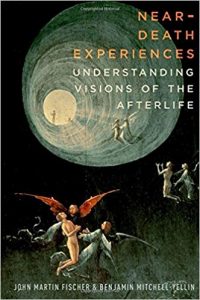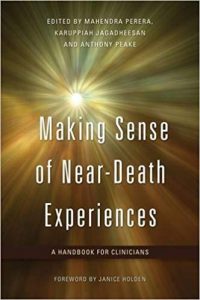Death and Transcendent Reality
David Lorimer

 MAKING SENSE OF NEAR-DEATH EXPERIENCES
MAKING SENSE OF NEAR-DEATH EXPERIENCES
Edited by Mahendra Perera, Karuppiah Jagadheesan and Anthony Peake
Jessica Kingsley, 2012, 176 pp.
ISBN: 978-1-84905-149-1
Buy Making Sense of Near-Death Experiences here.
NEAR-DEATH EXPERIENCES – UNDERSTANDING VISIONS OF THE AFTERLIFE
John Martin Fischer and Benjamin Mitchell-Yellin
Oxford, 2016, 191 pp.
ISBN: 978-0-19-046660-2
Buy Near-Death Experiences – Understanding Visions of the Future here.
Over the last 40 years, near-death experiences have become familiar to the general public and are now taken seriously within science and medicine – 65 NDE research studies have been published involving over 3,500 near-death experiencers. The debate about the interpretation continues to evolve, and these books are very differently angled in that respect. The first is a handbook for clinicians, with contributions from many leading international researchers, while the second is more polemical in trying to persuade the reader that NDEs can in fact be adequately explained on the basis of the physicalism taken for granted by the vast majority of scientists, doctors, philosophers and psychologists, most of whom know little or nothing about the research base of psi.
As Kenneth Ring says in his endorsement, the first book is indeed an invaluable resource for clinicians and other healthcare professionals who need to inform themselves about the nature and profound personal significance of NDEs. The book begins with an overview and early studies, moving on to a critical review of recent epidemiological studies with useful material for prospective researchers including criteria and questions for critical appraisal of studies referring to selection, volunteer and information bias, which the authors then explain. The next chapter explains the phenomenology of NDEs with some illustrative case histories and discussing hallucinations, drug induced states, OBEs and instruments for evaluating the NDE.
The chapter by Ornella Corazza on cross-cultural NDEs is one of the most interesting in the book, citing reports from China, Japan, India, Sri Lanka and Melanesia. Some of this was new to me and the influence of culture is clearly articulated, although the author does conclude that there are four essential common features: realness, transcendence, transformation and the value of the experience. There is some consideration of the psychological aspects of NDEs, also across cultures, and further contributions on the religious significance of NDEs, elements of end-of-life experiences by Peter Fenwick and the future of research. The authors of this last piece take the view that the field has been hampered by lack of precise definition and of falsifiable hypotheses regarding survival. They also point out that research into meaning and transformation can be conducted independently of the issue of veridicality, a point taken up in the second book.
Anthony Peake offers a fascinating contribution on light and near-death experiences, citing research from Dr Engelbert Winkler leading to the development of the Lucid Light Device (Lucia), which we featured at our last Beyond the Brain and helps simulate some of the elements of the NDE. Interestingly, the device was tested on some experts in dream yoga, who felt that the effects closely resemble spiritual experiences. This goes into a discussion of the pineal gland and the finding that it secretes DMT, which may be a substance responsible for the experiences with Lucia. This leads him to speculate about how we perceive inner and outer light and the question of their relative reality.
The article by Pim van Lommel on pathophysiological aspects of near-death experiences provides a convenient bridge into the second book, where his views are called into question. His pioneering work on cardiac arrest cases led him to conclude that the current materialistic view of the relationship between brain and consciousness is too restricted for a proper understanding of the phenomenon. He points out that the argument that a flatline EEG does not rule out deeper brain activity misses the mark as ‘the issue is not whether there is any brain activity of any kind whatsoever, but whether there is brain activity of the specific form regarded by contemporary neuroscience as the necessary condition for conscious experience, with visible and measurable simultaneous activities in many neural centres. And it has been proven that there is no such specific brain activity at all during cardiac arrest.’ (p. 92)
John Martin Fischer is a professor of philosophy and project leader of the Templeton Immortality Project, on which his co-author was a postdoctoral assistant. Their approach argues against what they call supernaturalism and makes the case that ‘there is good reason to try to fit our understanding of near-death experiences into the world view supported by the physical sciences.’ In taking this view, they do not denigrate the transformational nature and meaningful character of these experiences, but contend that this need not be associated with supernaturalism. They define supernaturalism as accepting one or both of two claims: that we have access to a supernatural realm separate from our physical world and that our minds are nonphysical ‘and the means by which we come to have experiences do not depend solely on our brains.’ (p. 8)
Their response to van Lommel’s position above draws on Popper and Eccles’ ‘promissory materialism’, namely the argument that neuroscience is still in its infancy (I’m not sure about that) and may well come to a definitive explanation of the NDE sometime in the future. This sidesteps van Lommel’s point about the brain activity understood to be necessary for conscious experience. In addition, they try to get round the finding that ‘because of occasional and verifiable out of body experiences we know that the NDE with all reported elements must happen during the period of unconsciousness, and not in the first or last seconds of cardiac arrest.’ Fischer maintains in relation to well attested cases that it is possible that the brain registered something at the time, and that the recall and report is cobbled together at a later stage, probably involving an element of false memory, even if this actually corresponds to the reported experience of independent witnesses. The authors admit that this is far-fetched, but strain towards what they call ‘physicalist-friendly’ explanations. This analysis would have to give a satisfactory account of all 100 cases cited in a recent study The Self Does Not Die. Here the devil is in the details, as these accounts strongly suggest that the experience did indeed happen at the time of unconsciousness, not as a subsequent recall.
Fischer and Mitchell-Yellin analyse a number of well-known cases, including the van Lommel dentures case, Pam Reynolds, Eben Alexander, and also the ostensible reincarnation memories of James Leuninger and the childhood experience of Colton Burpo. Their strength lies in the call for careful critical analysis and the avoidance of hasty conclusions, but in my view the approach is fundamentally flawed in its Procrustean efforts to shoehorn the NDE into physicalism by using some outlandish and far-fetched reasoning. For instance, they draw on terror management theory and false memory syndrome precisely because they are compatible with a physicalist theory of mind and the firm conviction that there is no afterlife. They apply this as an explanation of why people meet deceased relatives and not strangers in an NDE while ignoring the power of love and cases where the experiencer did not know the relative had died. They also miss the point that the transformational effects of the NDE are closely related to an encounter with spiritual light, often a being of light (this is true for mystical experience more generally), arguing that experiences such as the Grand Canyon can be as transformational. They also discount the experiencer drawing any conclusion that they have experienced an early stage of the afterlife, even if their arguments about sincerity and vividness not being proof of reality do hold some water.
With respect to the Leininger case there is no mention of the extensive University of Virginia database of more than 2,500 cases of children who remember previous lives, the careful research of Ian Stevenson and and his colleagues and the cautious conclusions that he draws from the data. Chapter 11 explains their multifactorial strategy to account for near-death experiences within the conventional physicalist framework of science. Here they reiterate their idea that veridical information may be explained as a construct and try to explain away significant elements of experiences, such as Colton Burpo telling his parents that he met an unborn sister [of whose existence he had no prior knowledge] who had ‘died in your tummy’ on the basis that all possible avenues of physical explanation should be exhausted before postulating anything beyond, otherwise there is no ‘explanatory progress’. They propose that he might have overheard his parents speaking about this or was using the story to gain attention.
They regard the difficulty of explaining how the nonphysical is supposed to interact with the physical as a knockdown argument against supernaturalism, while failing to point out the corresponding difficulty that neuroscientists do not know how consciousness is generated by the brain, on the assumption that it is. Very little attention has been given to the question of interaction apart from the work of Sir John Eccles suggesting a quantum interface. There is enormous resistance to any form of dualism in the Academy so very few academics have given this question any serious thought, preferring instead to conduct their research within a purely materialistic hypothesis. However, I certainly agree that more attention and research should be devoted to this question. More generally, it is true that the NDE cannot of itself be more than a suggested argument for an afterlife, but researchers should consider the enormous amount of data accumulated over 100 years suggestive of survival of consciousness and work out how these two are connected, as I have tried to do myself.
As with other sceptical books such as Quantum Leaps in the Wrong Direction reviewed last spring, the authors only apply belief perseverance and confirmation bias to the work of others. Here there is a whole chapter on this topic where the authors implicitly exclude themselves from this tendency to preserve one’s current stock of commitments. In my view it is also significant that Dr Eben Alexander’s NDE completely revolutionised his understanding of the relationship between brain and consciousness. Ultimately, readers will have to judge the evidence for themselves, and fundamental questions remain about the relationship between brain and consciousness, and the nature of reality. The greatest mystics of all traditions have reported their own systematic experience of a transcendent or supernatural realm, broadly corresponding to NDE reports – these all have to be dismissed as hallucinations or delusions if a strictly physicalist account of reality is to be maintained. We need to recognise that scientific materialism or scientism is a metaphysical theory and not a fact; and, as Larry LeShan has argued, when so-called impossible facts occur, it is the theory that needs revision or expansion, rather than dismissing or explaining away the evidence.
Buy Making Sense of Near-Death Experiences here.
Buy Near-Death Experiences – Understanding Visions of the Future here.
